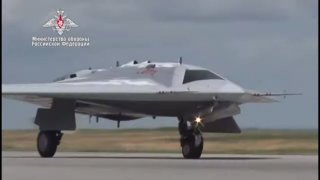Russia's 'Stealthy Heavy Attack' Drone Is Coming
Moscow's new weapon is very close to completion.
Key Point: Moscow has been modernizing its forces and building new weapons. Here is what it hopes to do with the Okhotnik.
Russia is pursuing additional tests, demonstrations and “familiarization flights” of its emerging Okhotnik stealthy heavy attack drone. These tests are intended to bring surveillance technology and stealthy assault mission options to this 5th generation aircraft.
The drone, which first emerged in August of last year, performed a joint flight with a Russian Su-57 last September. During that exercise, it “maneuver[ed] in the air in the automated mode at an altitude of around 1,600 meters and its flight lasted over 30 minutes,” according to a June 3rd report in TASS, Russia’s News Agency.
The upcoming tests and demonstrations are evolving, the paper explains, with a new Russian plan to insure the aircraft for more than $1.2 billion rubles in preparation for a new development phase. Additional exercises will include “engine runs, taxiing, ground-based work and system testing.”
The TASS article reports that the aircraft has a take-off weight of 20-tons and can hit speeds of roughly 1,000 kilometers per hour. It is being developed by the Russian Sukhoi Design Bureau.
Pictures of the aircraft seem to show an internally buried engine, thermal management configurations in the rear and internal weapons bays. Of course, much is not known about the drone, and there does not appear to be much information on its reported weapons arsenal. Various pictures do show what looks like an internal weapons bay release and there do not appear to be external hardpoints or weapons pylons. Interestingly, a look at its configuration might suggest it may actually be less stealthy than even a B-2, for several reasons. The top of the fuselage is less “rounded” with a wing-body melded shape but rather reveals sharper edges and a more angular design. While the TASS report says the Okhotnik is built with radar-absorbent materials, its shape may be more vulnerable to radar return signals by virtue of what appears to be a steeper, sharper incline from the wings up to the body. The structure seems to slightly resemble elements of the earlier U.S. stealth fighter, the F-117 Nighthawk.
Also, the fuselage shows a series of external vents or openings across the top of the aircraft, small protruding structures on the bottom and a large, visible exhaust tube on the back. The engine air duct inlets on the B-2, and what is now apparent on the B-21, appear embedded into the fuselage-wing area in a clear attempt to maximize stealth characteristics. This is because sharp edges, rougher seams and protruding structures are more likely to generate a return signal. After all, radar sends electromagnetic pings up into the air, bounces them off structures and then analyzes the return signal to develop a rendering of shape, size, speed and altitude of a threat object. The aim with platforms such as a B-2 is to build something with smooth, less detectable seams, the absence of angled vertical structures, external weapons pylons and an elaborate thermal management system intended to lower the heat signature. The B-2, for instance, is engineered to appear like a “bird” or even “insect” to enemy radar.
At the same time, despite the relative effectiveness of its stealth properties, the Russian attack drone does seem to have shown several additional attributes likely to be of concern for U.S. rivals. In particular, its flight maneuvers with a 5th-Gen Su-57 in one of its early demonstrations presents the possibility of some kind of manned-unmanned teaming wherein a 5th generation aircraft pilot operates a nearby drone from the cockpit. Such a technology, also rapidly being developed in the U.S. for F-22s and F-35s, can massively reduce latency by enabling direct connectivity or command and control between airborne platforms, obviating the need to transmit through a ground station. This improves reconnaissance options and, perhaps of greater concern, might enable a manned 5th-Gen fighter to operate at a safe standoff distance while conducting, managing and operating forward attacks with a heavily armed Okhotnik drone. The Okhotnik could operate and attack, over much higher risk areas such those heavily defended by air assets and ground-firing air defenses.
The degree of air-to-air coordination, networking or command and control between an Okhotnik and Su-57 may not yet be fully known. What is known is this kind of air to air connectivity is rapidly advancing. Datalink or RF connectivity of some kind between the two is very likely if not, to some extent, something which can be assumed. However, less known is the degree of operational command and control. Known as the "loyal wingman" concept, a drone controlled by a nearby manned-aircraft is a technology now being emphasized and developed rapidly by U.S. engineers and scientists. The technology is close, if not already here. Army helicopters, for instance, can already operate drone flight and sensor payload from the cockpits of Apaches and Kiowa Warriors.
Interestingly, the Russian TASS report does say the drone was “maneuvering in the air in automated mode,” while also making reference to the Okhotnik’s electro-optical cameras and radar, highlighting its forward reconnaissance technologies. Essentially, it is entirely feasible that the Su-57 and Okhotnik were networked or sharing information in some way during their joint demo flight.
Kris Osborn is the new Defense Editor for the National Interest. Osborn previously served at the Pentagon as a Highly Qualified Expert with the Office of the Assistant Secretary of the Army—Acquisition, Logistics & Technology. Osborn has also worked as an anchor and on-air military specialist at national TV networks. He has appeared as a guest military expert on Fox News, MSNBC, The Military Channel, and The History Channel. He also has a Masters Degree in Comparative Literature from Columbia University.
This first appeared in 2020 and is being reposted due to reader interest.
Image: Reuters

